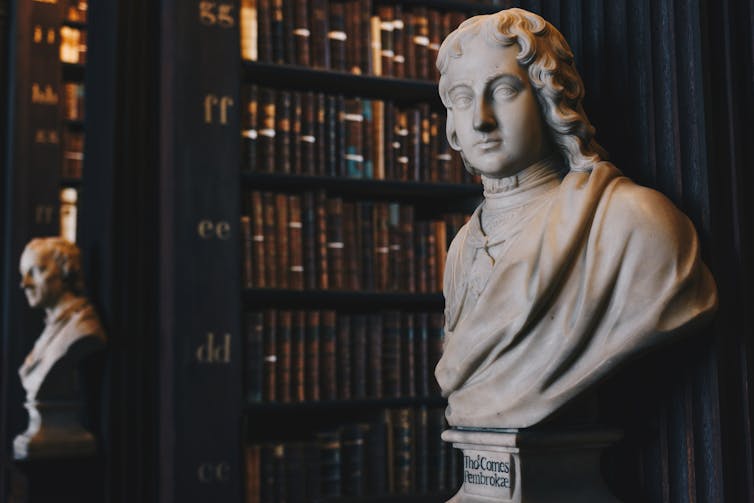51�Թ� the author: Grace McNutt is a PhD Candidate in History at
As countries reckon with racism, colonialism and genocide, . Across North America and Europe, statues — and this is a valid critique. Commemoration often blindly celebrates historic figures through statues and plaques without considering their controversies.
While , and have been subject to criticism as well, statues in particular have gripped public attention.
There are many possible reasons for this, such as statues being and the fact that they’re accessible. Another reason could be people’s reflexive association between history and statues — when we think history, we think statues.
As a history PhD candidate, I study our complicated relationship with statues and what purposes they serve. But you don’t have to study statues to see them everywhere. Statues grace the , and course syllabi.
People use statue-related language to describe the process of history-making, like “,” “” and “.”
These metaphors can be powerful, but also dangerous to history readers and writers. Metaphors have proven crucial to our learning process, but compared to whats being used now, there are better metaphors that could improve people’s understanding of the past instead of simplifying it.
Metaphors help people understand
Metaphors are used by many people to help convey a more abstract concept. For example, is often used by biologists to communicate the complex process of a cell.
There has been a considerable amount research conducted to understand how humans use metaphors and heuristics () to learn. Philosopher Thomas Kuhn and psychologists Daniel Kahneman and Amos Tversky (sometimes irrationally) to help navigate new problems.
Metaphors not only help us demonstrate and comprehend, but they also influence how we think at an unconscious level. In a study, psychologists found that using different metaphors to describe crime resulted in different solutions offered by participants.
If crime was described as a beast, then people suggested it needed to be controlled. If described as a plague, it needed to be contained. The words we use to describe the problem impact how we conceive of possible solutions.

History and statue-related metaphors
Statue-related metaphors, like “carving” and “setting in stone,” present history as solid, unchanging and definitive. But history is actually none of these things. and history is constantly changing.
The danger in these metaphors is they can subconsciously discourage reinterpretation, which can further contribute to sexist, racist and colonial influence in historical writing.
As , words that are used by a community help to define it — for our purposes, this would be historians/history consumers and history. Rupp uses the example of how some communities can use violent lexicon to describe sex by employing metaphors like banging, hitting, or slamming. He says: “When we used destructive things as tarnings for non-destructive things we impose some of the violence on the non-violent secondary metaphor. Since metaphor is a means of equating meaning, we are equating sex with violent action.”
Similarly, even if it is done innocently, statue-related metaphors suggest history is one-dimensional, contributing to a subconscious rejection of new historical interpretations of the past. This is contradictory to the efforts of many who seek to reverse the normalization of settler occupation and the exploitation of lands, resources and Indigenous Peoples.
There is already a growing resistance to these metaphors. Articles used in a tongue-and-cheek way to describe the removal and protesting of colonial statues.
River, tree and weaving
Historians have started to suggest new or revived under-used metaphors, ones that don’t relate to statues. A common one is comparing history to because it suggests change and fluidity. Another is a with many roots and branches that demonstrate how far reaching and diverse history can be.
If you ask me, a more apt metaphor would be weaving because historians should present One that is convincing, well-researched and sound — but not singular.
Anthropologist Tim Ingold suggests that . It could be thought of as applicable to history in many ways: 1) the creation is based on acquiring and arranging elements, 2) weavers may arrange similar elements in different ways and 3) good weaving relies on the skills of a weaver to create a sound warp and weft — the basic constituents of all textiles.
So historians, drop your chisels — statue metaphors are no longer needed.![]()
The article was . For more articles from Dalhousie, .
